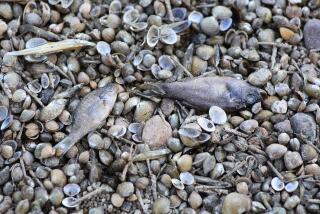Santa Barbara Invites Steelhead Back to Creek
- Share via
In April 2000, three adult southern steelhead trout departed from the Pacific Ocean during a storm and began fighting their way up Mission Creek through downtown Santa Barbara.
The smallest of the trio was 22 inches, the largest 29 inches. No one, not wildlife officials nor area anglers who watched, said they had seen fish that large in the creek in years. The steelhead probably had been living at sea for at least a year. They were fat and ready to spawn.
In the course of their short journey, they passed the Santa Barbara Pier, several popular hotels and businesses on State Street, the city’s main business artery. After swimming 1.2 miles, they stopped in a large pool, their upstream travel blocked by a concrete barrier.
Finally, as summer approached and the water warmed to intolerable temperatures for the fish, two of the three disappeared, most likely having returned to the Pacific. The third got sick. Biologists with the National Marine Fisheries Service and the California Department of Fish and Game tried relocating it to another creek farther north, but the fish soon died.
It was a sad ending to an inspiring odyssey, but it also spurred the town to reconsider the potential for its largest stream. Could a polluted urban creek cross-hatched with concrete flood-control barriers one day host annual spawning runs of a salmon-like fish?
“Those steelhead were a really big deal,” said Jill Zachary, the city’s creek restoration manager. “It ... elevated all these issues about Santa Barbara’s creeks. It might take a couple more decades to get steelhead back in Mission Creek on a regular basis, but we think, long term, it will happen.”
The fall after the three fish appeared, voters in the city overwhelmingly passed a local ballot measure to increase the hotel tax, with the proceeds -- about $2 million a year -- earmarked for restoring the city’s creeks. Steelhead, much like salmon, are seen as the ultimate indicators of stream health, because the fish, though tough, need healthy waterways to survive.
Steelhead are born in freshwater streams and rivers, migrate to the sea as adults and then return to creeks to spawn when they are 3 or 4 years old. Tens of thousands of steelhead once migrated up Southern California streams each year, often swimming high into the mountains, where the best spawning grounds could be found.
Today, only a few hundred steelhead appear in area streams each year. The southern steelhead, which inhabits Southern California, was put on the federal endangered-species list in 1998.
In many respects, Mission Creek is a classic steelhead stream. It begins as a spring-fed creek 3,000 feet above Santa Barbara and then drops steadily from the mountains to the coastal plain and, finally, to the ocean. The creek usually has water in it year-round and boasts many deep pools that hold water even during the driest of years.
East of town, in the Los Padres National Forest, Mission Creek and its largest tributary, Rattlesnake Creek, are comparatively free of contamination and are lined with oaks and sycamores that shade the water and keep it cool. The creeks there look much as they did when the Spanish missionaries settled the area in the 1780s.
But once in Santa Barbara proper, Mission Creek is beset by the two big problems common to most urban streams: polluted runoff and man-made obstacles.
To solve those problems, the city has begun a street-sweeping program to keep contaminants out of the stream. It is planting trees and shrubs on the stream banks to filter runoff before it hits the creek.
The city is also looking at removing the biggest obstacle -- the flood control barrier near the 101 Freeway that blocked the three steelhead in 2000. Another project is aimed at cleaning up a lagoon critical to the steelhead’s life cycle because it is where they make a gradual transition from freshwater to saltwater.
Brian Trautwein, a 36-year-old analyst for the nonprofit Environmental Defense Center, saw his first steelhead when he was 13 in nearby San Jose Creek. He has hiked nearly every mile of every stream in Santa Barbara County, looking for steelhead and steelhead habitat. Trautwein has been one of the most active proponents of the Mission Creek restoration.
“I’m cautiously optimistic for two reasons,” he said recently. “One is that people are finally starting to talk about removing these barriers, which isn’t rocket science. It just takes money.” The other reason, he said, is that it’s clear to those who take the time to look that there are plenty of trout still in Mission Creek.
In the last decade, scientists learned that steelhead and rainbow trout are genetically identical. For reasons not yet understood, some rainbow trout in coastal streams migrate to sea and become saltwater-tolerant steelhead, while other rainbows stay in freshwater all their lives.
There are hundreds of rainbows today in the upper part of Mission Creek and its largest tributary, Rattlesnake Creek. Trautwein firmly believes that all of them, now landlocked behind barriers, could one day make the round-trip from the mountains to the ocean and back.
To prove his point, Trautwein squatted beside Mission Creek and pointed to a trout. “That could be the progeny of a steelhead that went to the ocean five years ago or 50 years ago,” he said.
More to Read
Sign up for Essential California
The most important California stories and recommendations in your inbox every morning.
You may occasionally receive promotional content from the Los Angeles Times.










